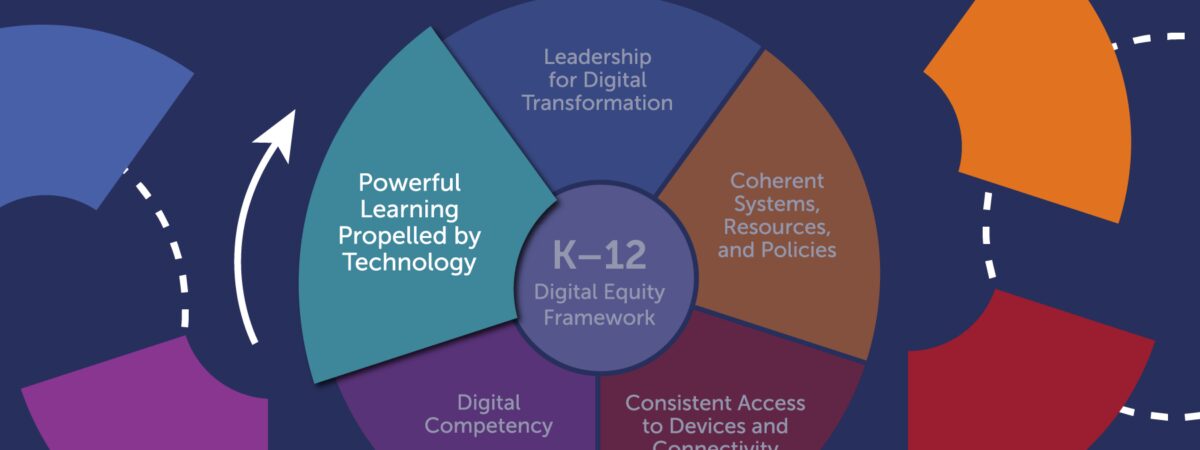
“We’re always talking about students’ data amongst ourselves,” Principal Guilford explained, “but we wanted to give the students the opportunity to look at their data and see how they would look at it and move differently.” This simple yet powerful shift—putting the data directly into the hands of the students—marked a significant departure from traditional practices. It demonstrates instructional culture setting—a core leader competency of the Powerful Learning Propelled by Technology domain of Digital Promise’s Digital Equity Framework. The domain promotes learner-centered instructional models that integrate emerging technologies and digital tools and resources into teaching and learning, resulting in high engagement and deep understanding.
The first step was a school-wide assembly, a bold move in any middle school setting. Imagine hundreds of students, buzzing with energy, suddenly confronted with their own academic data, including MAP scores and Lexile levels. Principal Guilford and his team didn’t just hand out reports; they took the time to explain the meaning behind the numbers, demystifying the data and making it accessible to students.
Anyone familiar with middle school assemblies knows the challenge of maintaining focus. Yet, Principal Guilford observed something remarkable: the students’ conversations were centered on their data. They were comparing scores, asking questions, and engaging with their academic performance in a way that was both surprising and encouraging.
“What we got out of that was self-awareness from the kids, accountability,” said Principal Guilford. “We empowered the students in that moment. And it flipped everything for us.”
The assembly was just the beginning. Principal Guilford then engaged in a dialogue with students, creating a growth reward system. This wasn’t a top-down mandate; it was a collaborative negotiation. Motivated by the prospect of a school-wide pajama day, students agreed that achieving six points of growth would be a worthy goal. Giving learners opportunities to use technology to express their voices and contribute to the decision-making process is another indicator of Powerful Learning Propelled by Technology.
“I think it was big because they set that tone for what they wanted to do in order to celebrate themselves,” Principal Guilford said, adding that the students with the highest scores and highest growth were recognized on monitors in hallways throughout the school. “Those students’ names are now scrolling through every day, so they get to see how important it is when you’re successful, when you’re taking your education seriously.”
To support this growth, Sylvan Hills implemented a daily “WIN” (Whatever I Need) block. This dedicated time allowed students to leverage their Verizon Innovative Learning Schools devices to access differentiated instructional materials, which were tailored to meet students at their individual learning levels, providing targeted support and opportunities for advancement.
“They’re able to go through at their own pace and not have to worry about what other students are doing and get disappointed if they’re not as advanced or having as much progress as others,” Principal Guilford said. “I think that individualized instruction with their own technology is important for them.”
With support from the school’s leadership team, including department leads, teachers received training during a staff meeting and professional learning communities (PLCs) on how to analyze test score data to inform instruction. This collaborative approach helped Sylvan Hills’ educators identify student needs more precisely, enabling them to design lessons to address the specific needs of students and focus on the skills they were ready to develop.
By sharing academic data with students, Sylvan Hills is cultivating a culture of equitable outcomes—another tenant of Powerful Learning Propelled by Technology. Students are no longer passive recipients of their education; they are active participants, understanding their strengths and weaknesses, taking ownership of their learning, and setting their own goals, which fosters accountability. When students understand their own data, they are more likely to take responsibility for their progress. They are no longer simply following instructions; they are actively working toward their own goals.
Most importantly, this approach cultivates intrinsic motivation. Students who are empowered to understand and track their own growth are more likely to be motivated to learn. They are driven by a desire to improve, not just by external rewards or pressures. “They said, ‘Hey, I want to do better. This Lexile is saying I’m at a third-grade level or a sixth-grade level and I’m in eighth grade. I know I’m better than that,’” Principal Guilford said. “The intrinsic motivation of them saying, ‘Hey, I’ve got to do better,’ was huge.”
The success at Sylvan Hills offers valuable lessons for educators everywhere. Principal Guilford suggests these three tips:
In a district landscape often defined by standardized tests and performance metrics, Principal Guilford is cultivating a culture of growth at Sylvan Hills Middle School, empowering students to take ownership of their learning and reach their full potential. Understanding that students achieve their greatest potential through continuous growth and empowerment, the team at Sylvan Hills are putting students at the center of their learning. This is not just about test scores; it’s about fostering a love of learning, building self-confidence, and empowering students to become lifelong learners.
“We’ve got a community of learners now,” Principal Guilford said. By embracing these principles, we can help all students achieve their full potential.
Want to learn more about other domains of the Digital Equity Framework? Read our blog posts about Leadership for Digital Transformation; Coherent Systems, Resources, and Policies; Consistent Access to Devices and Connectivity; and Digital Competency to gain a more comprehensive understanding of what it takes to achieve digital equity for all learners.
Thanks to Principal Larry Guilford for his contributions to this blog post!